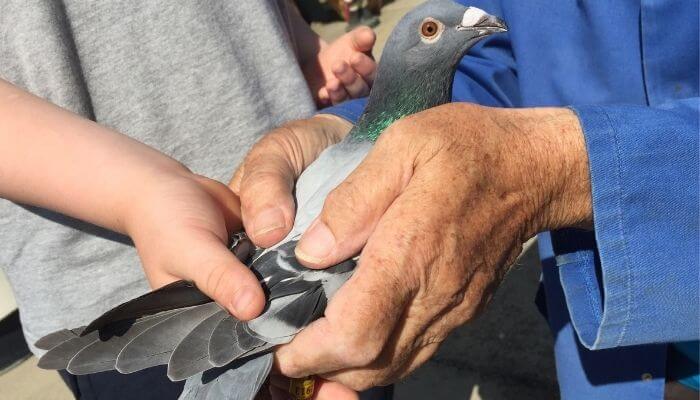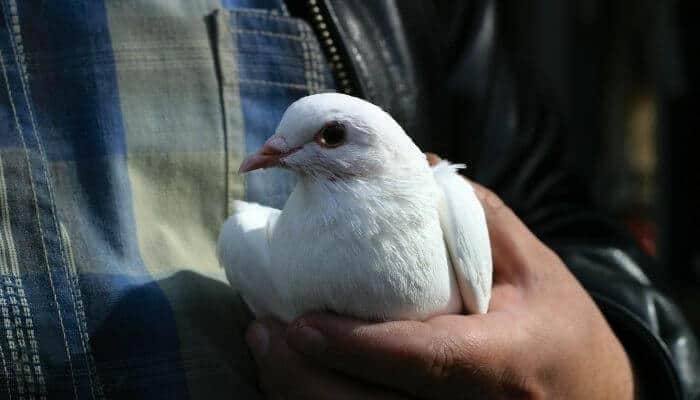Bird fancier’s lung is a disease that can sometimes affect people caring for or feeding wild or domesticated birds.
It is a respiratory condition that is not caused by a specific pathogen.

Handling your pigeons or the other birds you care for with care, using gloves and a face mask, especially when you clean their living space, is the best way of preventing this disease.
What is Bird Fancier’s Lung?
This condition can be defined as hypersensitivity pneumonitis.
The reason the word ‘pneumonia’ is not used for this disease is that it is not caused by a particular bacterium or virus or any other germs, for that matter.
Bird fancier’s lung is often the result of a person being exposed time and again to birds and their droppings.
It is more common in pigeon fanciers or people who own a lot of birds, including farm ones such as chickens.

When left untreated, Bird Fancier’s Lung can lead to pulmonary fibrosis.
Once this type of tissue degeneration happens, the lung loses its capacity to expand properly, which is why BFL sufferers could experience respiratory distress for the remainder of their lives.
What is interesting about the disease is that it is usually diagnosed based on the symptoms expressed by the patient.
There are several diagnostic methods currently used in human medicine that can reveal it, but they are quite complicated (such as radioscopy and bronchoscopy).
Another aspect worth noting about Bird Fancier’s Lung is that it tends to affect people with less capable immune systems compared to their healthy counterparts.
These are individuals who might be commonly exposed to second-hand smoke or who are smokers.
Other individuals, such as those that have chronic diseases like diabetes, have a higher likelihood of experiencing severe symptoms.
For this reason, it would not be unfair to say that Bird Fancier’s Lung is particularly dangerous for children, pregnant women, as well as seniors, especially since the latter are known to have chronic health issues.

This article was written by our qualified veterinarian Cristina.
This is part of our commitment to providing you with the most trustworthy veterinary advice for your pigeons.
What Causes the Disease?
What makes this condition so complicated is that there is no particular cause that can be discovered.
Consistent exposure to birds, in general, is the main cause, but if the disease were to be developed because of a microbiologic organism, some kind of treatment would prove to be effective.
However, most people develop Bird Fancier’s Lung by being exposed to allergens coming from birds.

These can range from the dust or ‘dander’ that birds, like any other animals, can produce, to dried droppings present in the birds’ living enclosures or on their feathers.
Some of the species that are known to transmit this disease to people are the following:
- Pigeons
- Chickens
- Turkeys
- Parrots
- Cockatiels
- Parakeets
- Turtle doves
- Budgies
The antigens can also be present in the birds’ bedding material.
As you might have noticed from the list of birds that can cause this condition, both pigeon fanciers and farmers are at risk of developing it, but also pet bird aficionados.
Symptoms of Bird Fancier’s Lung
Respiratory distress is the main clinical sign caused by this disease. However, it can vary a lot in terms of symptoms from one person to the next.

Not all people experience the same type of respiratory distress. Some might begin to be more careful while handling their birds, which is why there could be periods where the signs subside and then come back for a while.
The more severe forms of Bird Fancier’s Lung can lead to the following symptoms:
- Fever
- Weight loss
- Pain in the back or sides of the body
- Shortness of breath
- Dry, unproductive cough
- Low resistance to exercise
People who care for birds and who are also smokers might mistake some of these clinical signs for the usual respiratory distress and smokers’ cough that they experience on a regular basis.
Consequently, they might not seek out medical assistance, especially if they are not covered by their insurance.
Unfortunately, this also means that by the time they are seen by a pulmonologist, they might have developed lung tissue fibrosis – which is impossible to treat.
Diagnosing Bird Fancier’s Lung
A correct anamnesis often leads to a diagnosis in a short period of time.
However, when someone suffering from this condition goes to the doctor, they can expect to have several tests recommended.
Some of the basic ones can be CBC (complete blood count) and blood biochemistry. Advanced testing is also available in the form of radiology and endoscopy.
In some cases, and especially if none of the diagnostic methods used beforehand did not specifically point to Bird Fancier’s Lung, the doctor might recommend a lung biopsy.
The most common lesion that can be discovered histopathologically is granulomatous inflammation.
Can Bird Fancier’s Lung Be Treated?
Since this disease is not infectious, people can’t get antibiotics or other forms of anti-infectious medication.
The most common type of drugs currently being used in the therapy of Bird Fancier’s Lung is steroids.
However, these meds have their share of adverse reactions to the point that they could complicate the condition even more. This is especially the case for diabetic patients or those suffering from other chronic diseases.

The best way of ‘treating’ Bird Fancier’s Lung is to eliminate any avian protein and ensure that the patient no longer comes in contact with it.
Cleaning the birds’ living space is one way of going about things, but given the severity of the condition, doctors often recommend patients to quit raising birds altogether.
Even extreme cleaning procedures might not be able to remove all of the avian proteins present in the birds’ enclosures, not to mention that birds can also carry them on their bodies.
How Common is Bird Fancier’s Lung?
Some studies suggest that 1 in 10 pigeon owners develop this disease over the course of their lives.
It seems to be more common in people with ages over 50, mostly because these patients also have a less capable immune system compared to their younger counterparts.
While the prevalence of this condition is impossible to determine, according to some studies, it affects anything between .5% and 7.5% of all bird owners in the United Kingdom.
Prognosis and Recovery
The prognosis can vary depending on a number of factors, such as the patient’s age, whether or not they have other conditions and are receiving treatment for them, and also how often they are exposed to the avian proteins causing this disease.
Younger individuals are capable of recovering faster, especially since they also respond better to treatment with corticosteroids.
Senior patients are usually advised to quit caring for birds altogether as Bird Fancier’s Lung can put not just their general health, but also their life at risk.
How To Prevent Getting Bird Fancier’s Lung
There are cases where people have been handling birds for several decades and have never experienced any respiratory distress whatsoever, but then they quickly develop Bird Fancier’s Lung.
This happens because as bird owners age, their bodies become less equipped with the mechanisms capable of coping with the abuse that can be inflicted upon them by allergens.
So, even if you consider yourself a perfectly healthy individual, the best way to make sure that you do not get Bird Fancier’s Lung is to practice excellent hygiene.
Clean your birds’ living space every day or every two days and make sure that all of the enclosure is free from feathers and droppings.
Always wear gloves while performing the cleaning procedure. Wear a mask to make sure that the allergens do not even come close to your respiratory system.
Do consider that very severe cases require lung transplantation, so practicing good hygiene will not only prevent the disease, but also such dramatic outcomes.
If you have children, pregnant women, or seniors living in your household, avoid leaving them to care for the birds.
Sources:
- Bird fancier’s lung: clinical-radiological presentation in 15 cases, Raj Kumar & Mandeep Singh, Department of Respiratory Allergy and Applied Immunology, National Centre of Respiratory Allergy, Asthma, and Immunology, Delhi, India, in Advances in Respiratory Medicine, vol 83, no. 1, 2015. https://journals.viamedica.pl/advances_in_respiratory_medicine/article/view/PiAP.2015.0005/31854
- Bird Fancier’s Lung: An underdiagnosed etiology of dyspnea, Abigayle Syllivan, Pragya Shrestha et al, Respir Med Case Rep, 2020, 31 https://www.ncbi.nlm.nih.gov/pmc/articles/PMC7724370/
